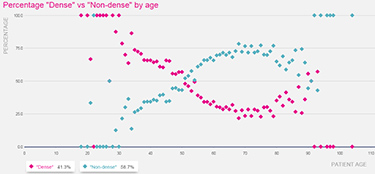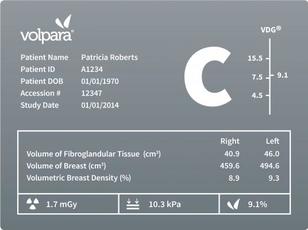Capital Imaging's Dense Breast Accuracy, Part 2
 A typical data map from VolparaAnalytics
A typical data map from VolparaAnalytics Capital Imaging, in Latham, NY effectively used their Volpara data to address a critical question from a referring physician.
Michael Masone, director of Capital Imaging, explains what happened, “About 8 months after we began our breast density program, we were contacted by one of our doctor’s offices. They were curious how many of the patients they sent to us were deemed to be dense. Evidently, their physicians were under the impression that 80% of the mammographies they were sending out were coming back to be dense. Their office refers to other centers and, knowing that the national average for dense breasts is about 40%, I wanted to confirm our numbers and get back to them as quickly as possible.”
Capital Imaging has VolparaAnalytics, which automatically collates data from digital mammography and tomosynthesis units to enable cross-comparison of patient populations, x-ray units, and operator performance.
“The referring office was concerned about their volume of dense breasts diagnosis.” said Masone. “So I was able to look at our data and let them know that only 30% of the patients they were sending to our facility were dense, significantly lower than their initial, anecdotal impression. Needless to say, that made them feel a lot better and cemented our relationship with them.
“When a state’s breast density law takes effect, referring physician’s may be surprised by the volume of density reports coming back because they’re not used to seeing them,” said Masone. “Volpara helps us provide both a clinical and quantitative evaluation of our mammography program, so we’re very confident that our process and results enhance our reputation in the community.”
Utilizing the unique, quantitative information provided by Volpara, breast centers can improve quality assurance, do better resource planning, and better understand the population they serve.
For more information about Volpara, follow this link or contact us directly.
For more information about Capital Imaging, visit their website via this link.
Michael Masone, director of Capital Imaging, explains what happened, “About 8 months after we began our breast density program, we were contacted by one of our doctor’s offices. They were curious how many of the patients they sent to us were deemed to be dense. Evidently, their physicians were under the impression that 80% of the mammographies they were sending out were coming back to be dense. Their office refers to other centers and, knowing that the national average for dense breasts is about 40%, I wanted to confirm our numbers and get back to them as quickly as possible.”
Capital Imaging has VolparaAnalytics, which automatically collates data from digital mammography and tomosynthesis units to enable cross-comparison of patient populations, x-ray units, and operator performance.
“The referring office was concerned about their volume of dense breasts diagnosis.” said Masone. “So I was able to look at our data and let them know that only 30% of the patients they were sending to our facility were dense, significantly lower than their initial, anecdotal impression. Needless to say, that made them feel a lot better and cemented our relationship with them.
“When a state’s breast density law takes effect, referring physician’s may be surprised by the volume of density reports coming back because they’re not used to seeing them,” said Masone. “Volpara helps us provide both a clinical and quantitative evaluation of our mammography program, so we’re very confident that our process and results enhance our reputation in the community.”
Utilizing the unique, quantitative information provided by Volpara, breast centers can improve quality assurance, do better resource planning, and better understand the population they serve.
For more information about Volpara, follow this link or contact us directly.
For more information about Capital Imaging, visit their website via this link.



